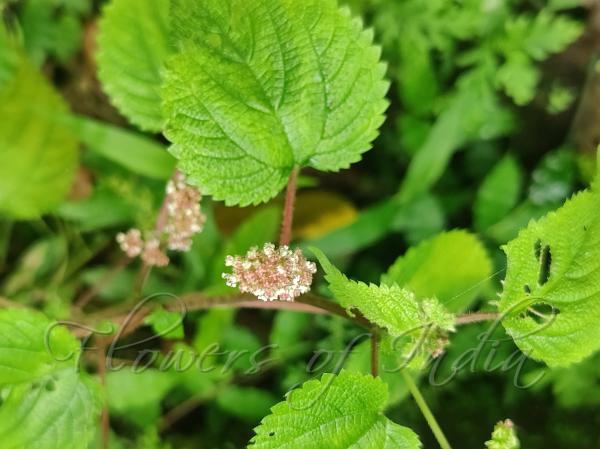|
| West-Indian Woodnettle |
|

|

| File size | 513042 |
| Original date | 8/23/24 2:53 PM |
| Resolution | 2048 x 1536 |
| Flash | Flash did not fire, auto |
| Focal length | 6.064mm |
| Exposure time | 1/94s |
| Aperture | 2.8 |
| Focus Distance | |
| Metering Mode | $meteringMode |
| Camera make | OnePlus |
| Camera model | OnePlus 9 5G |
| Sensor type |
|
|
|
|
Photo: |
Botanical name: Laportea aestuans Family: Urticaceae (Nettle family)
Synonyms: Urtica aestuans,
Synonyms: Urtica aestuans,
West-Indian Woodnettle is a little-branched, annual
plant usually growing up to 1 m tall, occasionally to 3 m. The stem is
fleshy, becoming slightly woody at the base, and the whole plant is
densely covered with stinging hairs. Leaves are broadly ovate to nearly
round, 9-20 x 6-16 cm, base rounded or abruptly narrowed, eared,
margins regularly sawtoothed or toothed, tip short-tapering. Flower
clusters have both male and female flowers in same panicle, or proximal
panicles with male flowers. Male flowers are about 2 mm across; tepals
4-5, equal in length; stamens 4-5, opposite tepals; filaments longer
than tepals. Female flowers are about 0.7 mm; tepals 2-4, appressed.
Seedpods are strongly compressed, round, about 0.9 × 1.3 mm. The
slightly mucilaginous leaves are often eaten as a vegetable and in
soups. West-Indian Woodnettle is found in India, Tropical Africa and
Tropical America.
Medicinal uses: West-Indian Woodnettle is
widely used in African traditional medicine. The leaves are diuretic
and laxative. They are often eaten as a vegetable or in a soup to treat
digestive disorders including stomach aches, indigestion and
constipation. An infusion of the leaf is taken for the treatment of
urine retention, bed wetting, haemorrhages, filariasis, rheumatism and
menopausal disorders.
West-Indian Woodnettle is
widely used in African traditional medicine. The leaves are diuretic
and laxative. They are often eaten as a vegetable or in a soup to treat
digestive disorders including stomach aches, indigestion and
constipation. An infusion of the leaf is taken for the treatment of
urine retention, bed wetting, haemorrhages, filariasis, rheumatism and
menopausal disorders.
Medicinal uses:
 West-Indian Woodnettle is
widely used in African traditional medicine. The leaves are diuretic
and laxative. They are often eaten as a vegetable or in a soup to treat
digestive disorders including stomach aches, indigestion and
constipation. An infusion of the leaf is taken for the treatment of
urine retention, bed wetting, haemorrhages, filariasis, rheumatism and
menopausal disorders.
West-Indian Woodnettle is
widely used in African traditional medicine. The leaves are diuretic
and laxative. They are often eaten as a vegetable or in a soup to treat
digestive disorders including stomach aches, indigestion and
constipation. An infusion of the leaf is taken for the treatment of
urine retention, bed wetting, haemorrhages, filariasis, rheumatism and
menopausal disorders. | Identification credit: Preetha P.S. | Photographed in Shenduruni forests, Kollam, Kerala. |
• Is this flower misidentified? If yes,